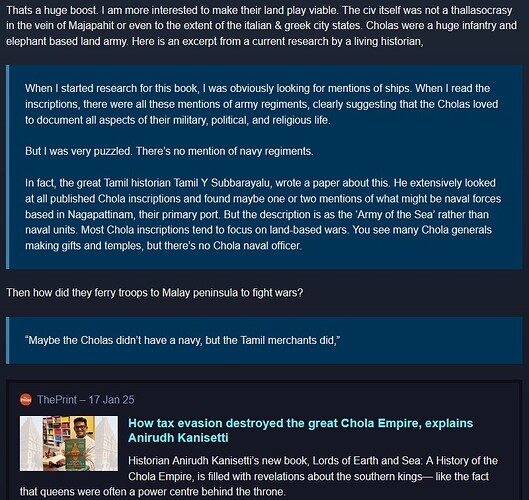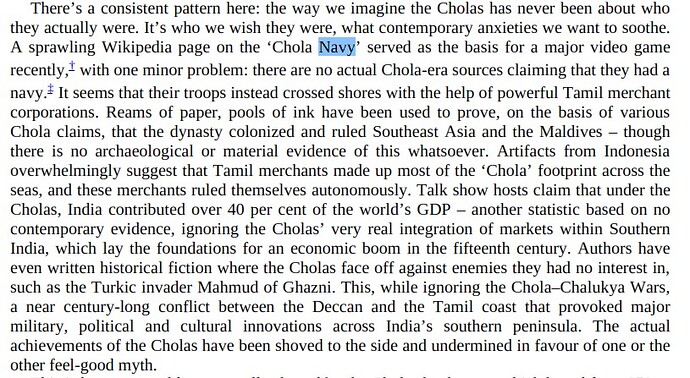With the new DLC inbound, I’ll share some East & SE Asian civs that I designed earlier, and we can compare and contrast my designs with the devs’ designs. I’ll explain the history behind my choice of the UUs. I can read Classical Chinese and most of my units are based on historical records.
UU Mangpung is based on Song era records about the pirates active on the South China Sea. Some of them were Chams, and some of them were South Chinese groups and others. There were a group of people known as the She (輋) in Guangdong from the 1170’s to the 1190’s who traded heavily with SE Asia by smuggling iron and salt. Some of these South Chinese groups could have collaborated or even worked for the Chams. Song records mentioned that pirates active along the southern coast of China in the late 12th century often wore paper armor. In terms of gameplay this unit is kinda similar to an amphibious version of Eagle Warrior, being a fast raider on land and a one-man raft throwing fire bombs on water. Though since it carries the ship armor class it’s countered by Camels and Spears.
Unique upgrade the Elephant Crossbowman is based on a Tang era record saying that the soldiers of Lam Ap (predecessor of Champa) wore rattan armors and used bamboo bows and crossbows on the backs of elephants.
This one is basically the civ that covers Nanzhao, Dali, as well as all other South China ethnic groups or chiefdoms during the medieval era.
UU Luojuzi is based on a Tang record about the elite soldiers of Nanzhao, and them being skirmishers is kinda my deliberate interpretation although there’re numerous historical records dating back all the way to the Han era saying that the tribes in Southwest were proficient at using javelins and shields.
2nd UU Raeuz Tribesman is again based on Tang record. The Nanzhao used some of those southern tribes as their vanguard forces when they invaded the Tang in 829-830, and those southern tribes really hated the Tang so much that when they captured a Tang civilian they would cut off his or her nose and ears. Of course my version is much less brutal than the ones from actual history. Mine is a gatherer / infantry hybrid unit which could transition between the two modes with a switch just like how the Ratha is switching modes. The term “Liao” (僚) is a medieval Chinese blanket term for all Non-Sinitic tribes in South China. It likely derived from the Tai-Kradai word “Raeuz”, meaning “we” or “us”. To avoid any confusion with the Khitan Liao (遼) Dynasty (which these southern tribes had absolutely nothing to do with by the way), I decided to give them the Tai-Kradai Cuengh name “Raeuz”.
Looking back at my Tangut civ design from last year I feel that I was being a bit too conservative, especially when it comes to their UU.
The design of my Tangut UU is based on the Song record of the Tangut Poxi army with camel mounted catapults, although instead of designing it as a mobile siege unit like the devs did, I made it into sort of a mounted slinger on a camel with its primary focus being anti-infantry. I just didn’t think a fast siege unit would work in the game. Imagine a camel siege unit with similar range as a Mangonel or a Trebuchet but having 1.45 speed, it would be such a OP unit. With such a unit even noobs can beat Hera or the Viper under the right circumstances. Although to be fair to my design, historical records did mention that the Poxi was primarily used to deal with Song infantry and was not used in siege battles.
The 2nd UU Bubazi and the unique structure the Taojili Landmine were designed based on Song records as well as actual archaeological samples of the ceramic landmine.
The Tibetan UU is based on Tang records of Tibetan infantrymen, saying that they were especially strong in melee since their lances were longer and pointier than the ones used by the Tang Chinese. Their ability of having a pierce charged attack (by launching a javelin) is again based on records saying that tribes in the southwest of China were proficient with javelins.
Unique upgrade Imperial Steppe Lancer is kinda self-explanatory, though still based on Tang records about Tibetan lancers.
Gompa is their unique Monastery which is able to self-convert passing enemy units (same conversion speed and rate as a generic Monk without upgrades or civ bonuses), and Lama is their unique Monk which apart from having slightly higher HP than a generic Monk also has the ability to build and repair the Gompa.
This one is supposed to be a civ that covers all early medieval North and Central Asian Turkic tribes.
Their UU the Chuy / Shatuo Cavalier is based on Tang records about the Shatuo people (Chuy being their endonym whereas Shatuo being the name given to them by the Chinese). They were originally a Western Gokturk tribe active in Central Asia before being pushed to the east by the Saracens and the Tibetans, seeking refuge in Tang territory. The Tang granted their asylum but also used them as shock cavalry to suppress internal rebellions and unruly warlords.
This is perhaps the only civ in my designs which isn’t based on medieval Chinese records but rather based on a documentary I’ve watched about the Sukhothai and Ayutthaya kingdoms. This civ is supposed to cover all Indianized SE Asian Tai tribes, though it does not cover the Sinicized Tai-Kradai peoples who stayed in South China as those are covered by my Bo/Baipu civ instead.
Their UU the Elephant Arquebusier is based on a late medieval SE Asian unit common among SE Asian armies (not just among Thais although they continued to deploy such units all the way till the 19th century).
2nd UU the Chaturongkhabat is based on historical Ayutthaya infantry unit carrying the same name, their duty being protecting the war elephant from the attacks of enemy infantrymen.
3rd UU the Sangha is based on Theravada monks from SE Asia, although it being a mounted elephant monk is largely based on the Indian Brahmin explorers from AoE 3.
Also gave SE Asian civs a regional unit called the Apsara Dancer which is trained from their Monastery. It’s more of a meme / niche unit to give women more representation in the game (cause someone criticized my designs as lacking female representation). Though the Apsara Dancers did exist in real history not something I made up. Although being largely meme / niche, when used correctly this unit could influence the outcome of a battle with her aura effects, despite not having any means of attack herself.
This civ of course covers the historical Jin dynasty as well as previous Tungusic kingdoms/chiefdoms like Sushen, Mohe, and Balhae / Bohai, and it partially covers the later 16th century Manchus as well.
The primary UU the Thunder-Crash Grenadier is based on Song records about the use of iron bombs and grenades among Jin armies, particularly during a siege battle between the two sides in 1221.
The 2nd UU the Iron Flail is based on the Iron Pagoda, though the reason I didn’t name it as such is because a few first-hand Song accounts claimed that the Iron Pagoda was a heavy siege infantry. The Iron Flail pays homage to AoE 3 as it echoes the unit with the same name in that game. Historically the flail was a weapon commonly used by the northern Asian peoples, the Jurchens, the Tanguts, the Chinese, the Mongols, and the Koreans all used it as a cavalry weapon, though for balance concerns I didn’t make this a regional unit.
The 3rd UU Doi Boat is based on medieval Japanese records about Jurchen pirates raiding the coasts of Japan in the year 1019 (if I remember correctly). I just think it’s time that we have a cavalry and cavalry archer civ that could be above average on water maps, and the Jurchens are a perfect candidate for such a civ.
Also gave East Asian civs (Chinese, Koreans, Jurchens, and Tanguts) the regional unit Fire Lancer like what the devs did with their new DLC. However unlike the devs my version is a flamethrower type akin to a Fire Ship on land. Based on a Song account from 1132, bamboo fire lances were used to set fire on enemy siege engines, which is where my idea of them being a flamethrower type unit came from.
Please share your honest thoughts and opinions about my civ designs, thanks for viewing.


